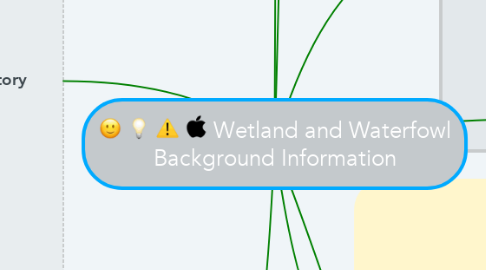Wetland and Waterfowl Background Information
by Avah Sannicolas-Youngs


1. INTRODUCTION
1.1. Wetland are the habitat of waterfowl
1.2. Wetlands and Waterfowl are important to Michigan's heritage
1.3. The number of wetlands are reducing in Michigan
2. History
2.1. A third or more of the state was covered by wetlands
2.2. Indian cultures made use of the wetlands
2.3. Major wetlands
2.3.1. Marshes
2.3.1.1. Flooded grasslands
2.3.1.2. Standing water from one inch to several feet deep
2.3.2. Swamps
2.3.2.1. Flooded woodlands or shrub-lands
2.3.2.2. Dominated by plants
2.3.3. Bogs
2.3.3.1. Occur when accumulations of decaying vegetation cover or fill in old ponds or kettle lakes
2.3.3.2. Soil is high acidic
3. Wetland Regulations
3.1. State law that provides for the preservation and proper management of wetlands
3.2. Prevent environmental degradation that is caused by certain activities
4. Management Considerations
4.1. Restore any drained or degraded wetlands you find
4.2. Plant upland nesting areas
4.3. Mow grasses between July 15 and August 30
5. Why are wetlands important
5.1. Wetlands play an important role in the management of our water based resources
5.2. Wetlands produce more wildlife and plants then any other Michigan habitat
5.3. Contribute to natural nutrients and water cycles
6. What are the threats to wetlands
6.1. Filling and drainage by humans
6.2. Commercial,industrial and residential expansion
7. Annual cycles and seasonal needs
7.1. Throughout summer and fall waterfowl acquires as much protein as possible
7.2. In summer waterfowl use wetlands area to rest
7.3. Variety of wetlands are needed to meet the seasonal needs of waterfowl
8. Life cycles of three common waterfowl
8.1. Wood ducks
8.1.1. Arrive in Michigan from southern winter areas
8.1.2. Feed on acorns and aquatic seeds
8.1.3. Water depths of 8 inches are ideal for wood ducks
8.2. Blue winged teal
8.2.1. Prefer temporarily flooded shallow wetlands
8.2.2. Nests in upland grasses or wet meadow sedges
8.3. Mallard
8.3.1. Hens like grassy areas to lay their eggs
8.3.2. Nest sits may be up to a mile away from wetlands

